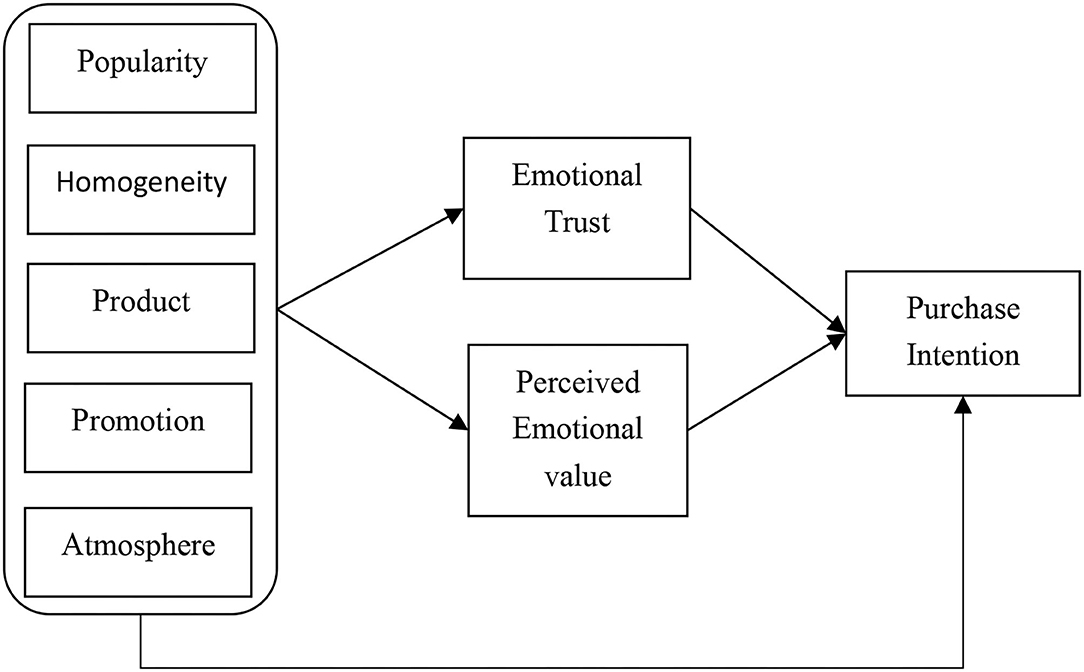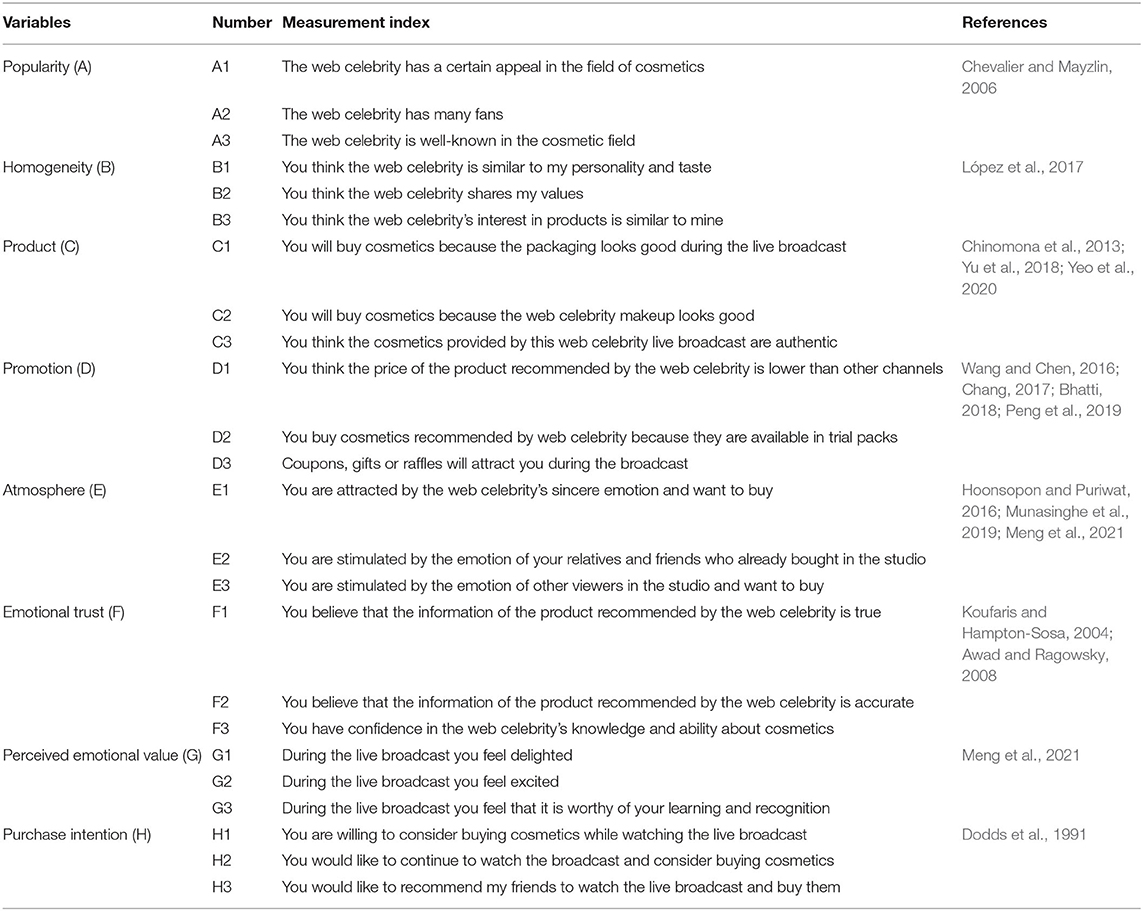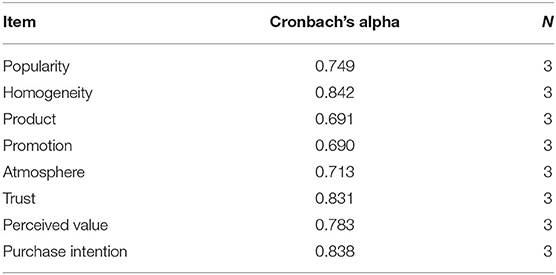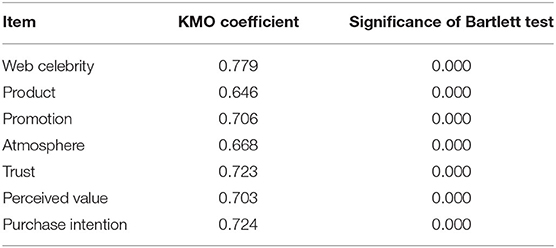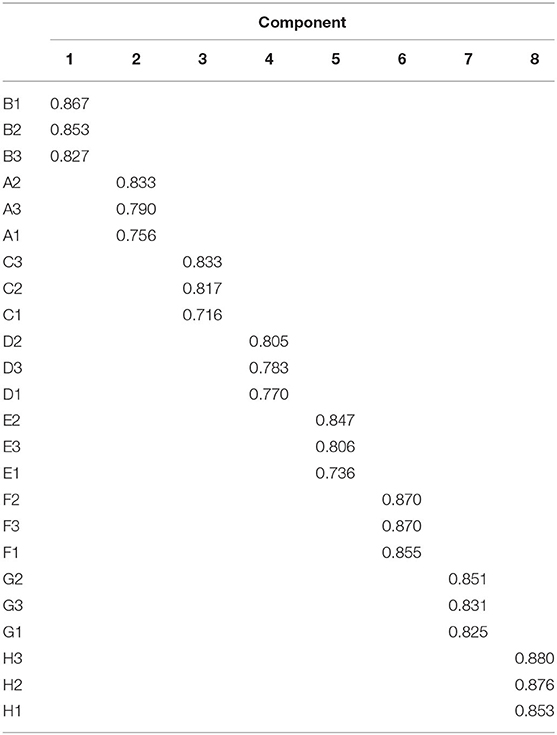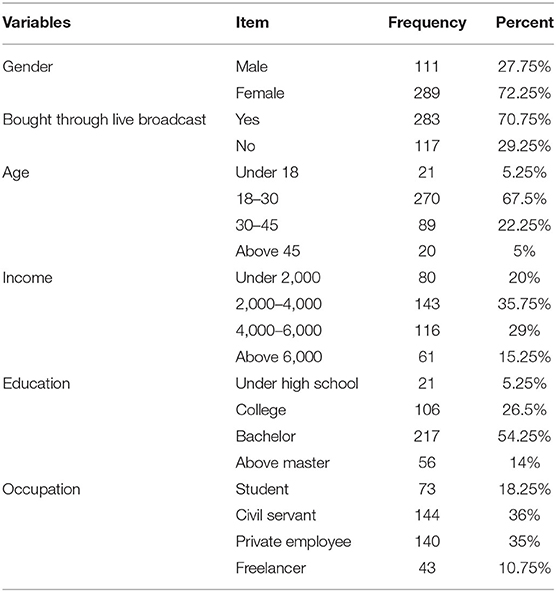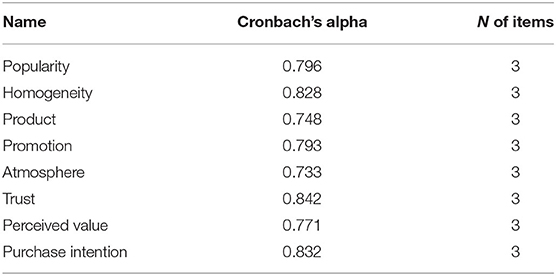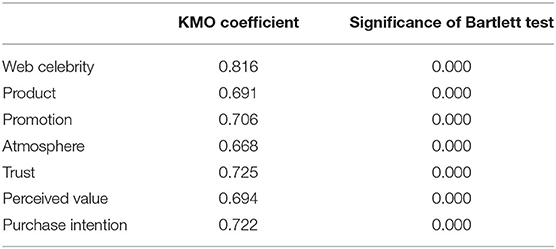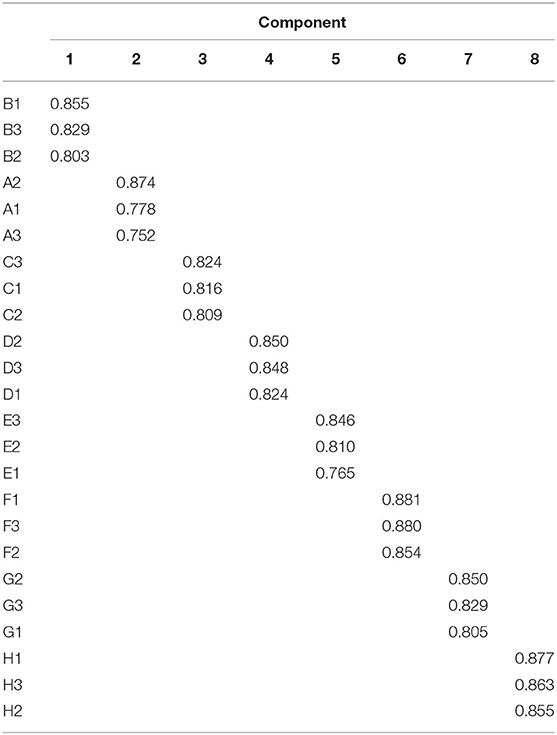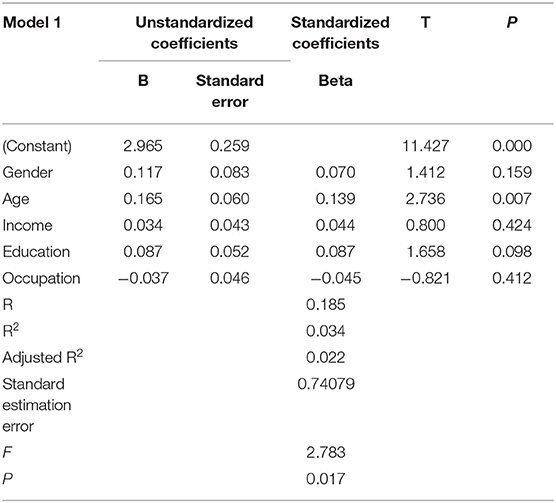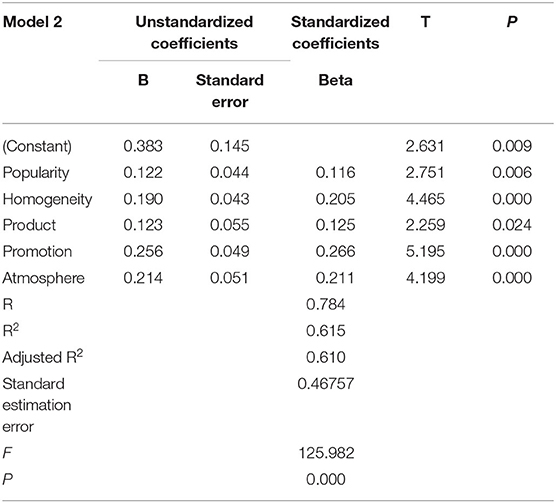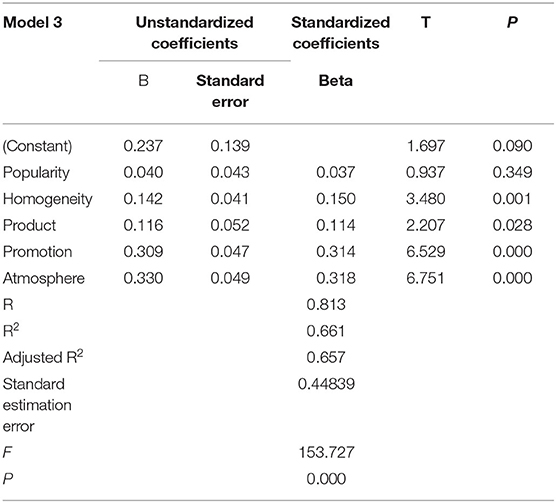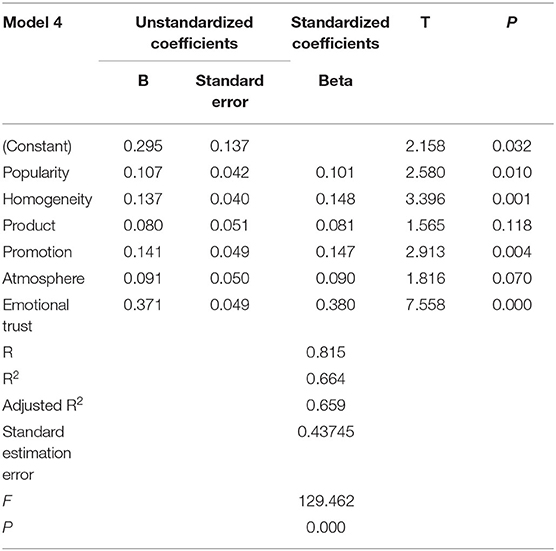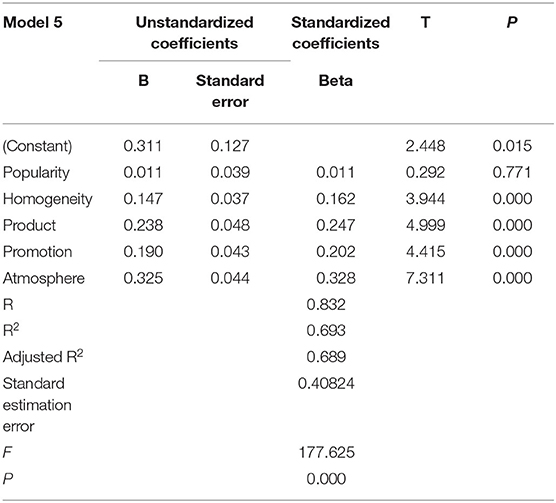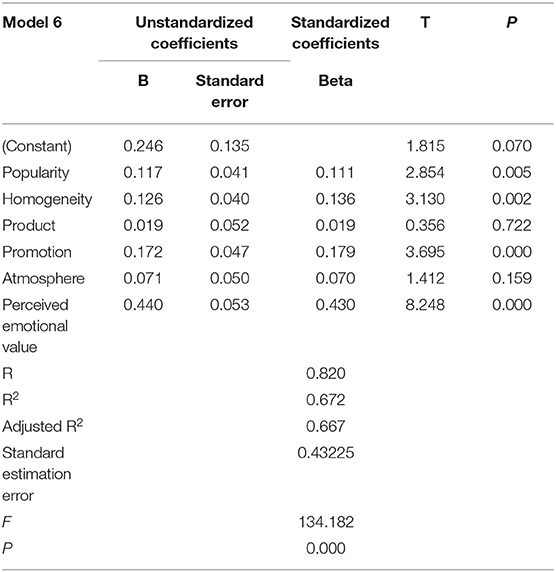- 1Department of Development Studies, Faculty of Business and Economics, University of Malaya, Kuala Lumpur, Malaysia
- 2Faculty of Tourism Management, Wuhan Business University, Wuhan, China
With the deep popularity of mobile Internet, the “eyeball economy” is more active than ever. Driven by powerful modern media, livestreaming, as a new form of attracting public attention to obtain economic benefits, is worth studying its influence path on consumers. Based on the technology acceptance model and the mediating effect of emotion, this study constructs the consumer influencing factor model of livestreaming e-commerce. The research model and related hypotheses are verified by SPSS and linear multiple regression models. The research found that emotional trust and perceived emotional value could be regarded as mediating variables to stimulate consumers' purchase intention in livestreaming e-commerce. They have a full mediating effect on product and atmosphere and a partial mediating effect on homogeneity and promotion, which identifies that online celebrity's homogeneity, and sales promotion could influence consumers' purchase intention through the partial mediating role of emotional trust and perceived emotional value, while product and atmosphere induced by emotional contagion could exert influence on consumers' purchase intention through the full mediating effect of emotional trust and perceived emotional value.
Introduction
E-commerce live broadcast (livestreaming e-commerce) is a type of e-commerce in which live broadcast is used as a marketing channel (Kang et al., 2021; Xie C. et al., 2022). It is the result of the two-way integration of live broadcast and e-commerce in the digital age (Wongkitrungrueng and Assarut, 2020; Zhou et al., 2021). E-commerce live broadcast uses live broadcast to reconstruct the three elements of “people, goods, and field,” but its core is still e-commerce (Xue et al., 2020; Lu and Chen, 2021). Compared with traditional e-commerce, e-commerce live broadcast has the advantages of high interaction and high conversion rate (Xu et al., 2021). The live broadcast e-commerce industry chain is made up of the supply side, the platform side, and the consumers. The upstream supply side primarily consists of commodity suppliers (e.g., manufacturers, brands, distributors, and origin) (You, 2020); the midstream primarily consists of live broadcast service providers, channel platforms (e.g., e-commerce platforms, content platforms, and social platforms) (Liu et al., 2021), and anchors (e.g., Internet celebrities, star artists, entrepreneurs, and other anchors); and the downstream demand side primarily consists of consumption (Maier and Wieringa, 2021). In the traditional centralized e-commerce model, the platform is the center of transactions and communication between brands, merchants, and consumers, and it has tight control over flow, transaction data, and customer relationships (Yue et al., 2019; Varadarajan et al., 2021; Peruchi et al., 2022). With the development of socialization, containerization, and decentralization of e-commerce, the platform's strong control over merchants and consumers has gradually eroded (Li et al., 2021), allowing brands, merchants, and consumers to have direct contact with consumers and make sales conversion more efficient and cost-effective (Gielens and Steenkamp, 2019; Wedel et al., 2020). From flow acquisition to conversion operations, the value of private domain flow is increasing.
As the flow cost of centralized platforms continues to rise, the platform's control over flow has weakened to varying degrees (Loux et al., 2020; Wagner et al., 2021). On the one hand, the centralized e-commerce platform began to receive external flow through technical cooperation, investment and acquisition, and so on (Cui et al., 2017; Malacina et al., 2022); on the other hand, the platform's flow control has tightened further, causing more flow to be concentrated on head companies and clearing out mid- and long-tail merchants (Chiu and Wong, 2021; Gao et al., 2022). Under these conditions, the combination of small- and medium-sized businesses and private domain flow becomes even more important (Jun et al., 2020). When the flow is plentiful, a significant amount of free or low-cost public domain flow can be converted into private domain flow of brands and merchants, with the private domain flow of merchants being deposited on the platform and becoming the platform's public domain flow (Xie X. et al., 2022). When the flow dividend falls, however, the platform's demand for public domain flow control and monetization rises, amplifying the conflict between public and private domain flow (Fu et al., 2022). Second, private domains are not a brand-new idea. Address books and emails were all examples of private domain flow before social networking became popular (Cozzolino et al., 2021). The connotation of private domain flow has been further extended with the emergence of social platforms, such as WeChat and Weibo.
On the one hand, many brands and merchants have amassed a portion of the initial “fans” in the traditional e-commerce model, but users of the centralized platform belong to the platform, and their relationship with the brand merchants is not close (Phang et al., 2013; Ertz and Boily, 2019). Importing users into their own platforms is the only way to achieve controllable private domain flow (e.g., independent app, WeChat group, official account, personal account, and corporate WeChat). Brand merchants, on the other hand, must pay for public domain flow pool exposure, which will continue to rise in price (Wong and Ngai, 2021; Zheng et al., 2022). In contrast, while merchants must also operate and maintain private domain flow, the cost of acquiring customers is relatively low and long term (Peck et al., 2013; Kumar et al., 2017). Finally, as more people become aware, brands and merchants will be able to establish private domain flow pools, allowing them to expand their business. Livestreaming e-commerce emerges at a historic moment and is worth studying its influence path on consumers. Based on the technology acceptance model and the mediating role of emotion, this study constructs the consumer influencing factor model of livestreaming e-commerce. The research model and related hypotheses are verified by SPSS and linear multiple regression models.
In conclusion, the main theoretical contributions of this study are as follows. Although there are many literatures on emotional marketing and livestreaming e-commerce, this study is the first to use emotional trust and perceived emotional value as mediating variables to study the effect of emotion on consumers' purchase intention in livestreaming e-commerce. In addition, although there are many literatures on opinion leader, marketing mix, and emotional contagion previously, this study is the first to take the characteristics of online opinion leaders, product and promotion, as well as atmosphere induced by emotional contagion as independent variables, plus emotional trust and perceived emotional value as intermediary variables, to study how these variables influence consumers' purchase intention through the mediating effect of emotion in livestreaming e-commerce.
Literature Review and Research Hypotheses
Emotional Marketing, Emotional Trust, and Perceived Emotional Value
With the continuous development of the digital economy, plus traditional marketing activities could not excite consumers, emotional marketing becomes a key explanatory construct in the field of consumer behavior (Honea and Dahl, 2005). Previous studies have shown that emotional reaction could be triggered by the physical purchase environment (Yoo et al., 1998), the virtual shopping environment (Meng et al., 2021), product displayed (Oliver, 1994), price promotion (Aydinli et al., 2014), and emotional attachment to online celebrities (Ladhari et al., 2020). These emotional responses have been shown to influence attitudes, evaluations, and behaviors (Honea and Dahl, 2005).
Emotional trust is the trust formed between the trusting party and the trusted party on an emotional basis; it is concerned about the welfare of the trusting party and takes full account of the trusting party's purpose and intentions; it relies on good communication (Chua et al., 2008). Emotional trust is based on mutual interaction and attraction; frequent communication and exchange between individuals deepen the relationship over time and shows concern for the welfare of the trusted person (Mian and Hattab, 2013). Consumers' perceived trust in online retailers influences their emotional trust, which in turn enhances purchase intentions (Zhang et al., 2014). Consumers have emotional trust in the brand community, which increases their willingness to buy the brand (Habibi et al., 2014). Emotional trust will influence consumer purchase intentions (Awad and Ragowsky, 2008). Consumers are more likely to choose products recommended by trusted opinion leaders because their emotional trust influences their purchasing decisions (Koufaris and Hampton-Sosa, 2004).
Perceived emotional value is associated with the feelings of affection, love, connection, and passion. It is recognized that consumers will perceive the emotional value to products, promotions, environment, brands, and celebrities (Thomson, 2006; Dwivedi et al., 2018). Emotional value measures the perceived utility that consumers associate with a product or service's ability to elicit an emotional or affective state (Sheth et al., 1991). Emotional value is influenced by the benefits consumers derive from the goods or service (Sweeney and Soutar, 2001). Rational and emotional factors associated with a product or service play an important role in all purchase decisions (Mackay and Mackay, 1999). Therefore, this study aims to study the mediating effect of emotion in livestreaming e-commerce. In this article, emotion is divided into two mediating variables, namely, emotional trust and perceived emotional value.
Online Celebrity
Opinion leaders have a deeper understanding of products and services, can provide information and advice to others, and have a significant influence on the attitudes of followers (Rogers and Cartano, 1962; Stern and Gould, 1988), so online celebrities can be considered network opinion leaders to some extent. Network anchors, unlike traditional opinion leaders, regularly release self-created topics on social media or e-commerce platforms via network live broadcasts, videos, photos, blogs, and other means to influence their followers (Mcquarrie et al., 2013; Khamis et al., 2017; Lin et al., 2018). Opinion leaders can provide informal and consumption-related advice to other consumers to assist them in reducing the risks associated with purchasing decisions (Engel et al., 1995; Flynn et al., 1996). Online reviews from reputable or well-known participants have a significant impact on product sales (Chevalier and Mayzlin, 2006). Hence, an increasing number of marketers rely on network celebrities or anchors to persuade e-commerce users to buy (Kim and Kim, 2021; Tafesse and Wood, 2021).
The five main characteristics of Internet celebrities that promote impulse buying are popularity, recognition, homogeneity, social distance, and perceived fit (Li and Du, 2011; Chen et al., 2021), respectively. According to Amazon platform research and analysis, the more famous people are, the more likely they are to have an impact on consumers, resulting in an increase in product sales (Chevalier and Mayzlin, 2006). Consumers' purchase intentions can be influenced by popularity by increasing their emotional trust in anchors (Huffaker, 2010; Edwards et al., 2013). Emotional trust can alleviate hesitancy and expedite the purchasing decision-making process (Chen et al., 2021). Furthermore, the greater the influencer's popularity, the more consumers believe that the products recommended by the influencer have perceived emotional value, resulting in increased purchase intent (Chen et al., 2021). In terms of social media, Kowalczyk and Pounders (2016) reported a positive and significant impact of emotional trust and emotional value to the popularity of traditional celebrities on the likelihood of brand purchase. In general, popularity can influence a consumer's purchase intention both directly and indirectly through emotional trust and perceived emotional value.
The nature of homogeneity is that people tend to imitate others in order to keep up with social trends, which are influenced by values (Kamins, 1990). Consumers tend to imitate Internet celebrities whose values are comparable with their own and purchase the goods they use and recommend (Dittmar et al., 1996). Hence, homogeneous Internet celebrities can directly influence consumers' purchase intention. In addition, Internet celebrities share personal thoughts about products and life, and the presentations seem casual and very real to the audience (Golbeck, 2016). They interact with their followers by liking, commenting, sharing, and retweeting, so users feel that they have a psychological closeness to the online celebrity. Although proximity and reciprocal exchange/relationships are “fictional” (or illusionary) social relationships, consumers are more likely to place emotional trust and emotional value on them. The frequency of live broadcasts, the duration of the live broadcasts, and the viewers' memories (i.e., recall of these exchanges and experiences) reinforce these emotional trust and emotional value. Hence, homogeneity can stimulate consumers' purchase intention through increasing their emotional trust and perceived emotional value (López et al., 2017; Chen et al., 2021). As a result, hypotheses 1 and 2 are proposed:
Hypothesis 1: As Internet opinion leaders, Internet celebrities' popularity has a positive influence on consumers' purchase intention directly and indirectly through emotional trust or perceived emotional value.
Hypothesis 2: As Internet opinion leaders, Internet celebrities' homogeneity has a positive influence on consumers' purchase intention directly and indirectly through emotional trust or perceived emotional value.
Atmosphere and Emotional Contagion
Emotions are essentially emotional reactions to personal and social experiences (Du et al., 2011). Individual emotions are influenced by others and their environment in terms of emotional response (Du et al., 2011; Fan et al., 2018; Sun et al., 2019). Customers' emotional responses to the virtual environment of online shopping can influence their behavior (Sun et al., 2019). Furthermore, among consumers who do not interact directly, the emotions of other consumers will influence the emotions and purchase intentions of consumers (Chuah and Yu, 2021). As more conversations and tasks take place in virtual environments, such as e-commerce platforms, emotional contagion can occur without a physical location (in many cases, only through text-based interactions) (Meng et al., 2021). Emotions, according to the existing research, can spread virtually between individuals or groups, as well as more broadly via social networking platforms (Peck et al., 2013; Kramer et al., 2014; Del Vicario et al., 2016; Chuah and Yu, 2021; Soderlund et al., 2021). In addition, emotion around the environment could stimulate emotional trust and perceived emotional value, thus stimulating consumers' purchase intention (Pornpitakpan, 2004; Wen et al., 2009; Munasinghe et al., 2019). Therefore, consumers' purchase intention may be influenced by the atmosphere around the live studio on consumers' perceived emotional value and emotional trust. Thus, hypothesis 3 is proposed.
Hypothesis 3: The atmosphere around the live studio during the live broadcast process has a positive influence on consumers' perceived emotion value and emotional trust, thereby influencing consumers' purchase intention.
Promotion and Product
The marketing mix is comprised of the “4Ps” (e.g., product, price, place, and promotion) (Mccarthy and Perreault, 1964; Borden, 1965). As a result of advancements in marketing mix theory, marketing mix has been redefined as a collection of thousands of trace elements gathered together to simplify management activities (Kalyanam and Mcintyre, 2002). Every product evokes a quick, effortless emotional response (Aydinli et al., 2014). Product quality or package is an important factor in directly increasing consumers' purchase intent by influencing consumers' emotional trust and perceived emotional value, thus stimulating consumers' purchase intention (Chinomona et al., 2013; Shaharudin et al., 2013; Hussain et al., 2015; Saleem et al., 2015; Yang et al., 2019).
Promotion should increase the relative impact of emotional value on purchase decisions (Aydinli et al., 2014). Promotions effectively increase consumer emotional trust and perceived emotional value, motivating cosmetics consumers to purchase (Bhatti, 2018; Peng et al., 2019). Therefore, promotion can directly or be based on emotional trust and perceived emotional value to consumers' purchase intention. Therefore, hypotheses 4 and 5 are proposed.
Hypothesis 4: Promotion positively improves consumers' purchase intention during the live broadcast process, and emotional trust and perceived emotional value play a mediating role.
Hypothesis 5: Product positively improves consumers' purchase intention during the live broadcast process, and emotional trust and perceived emotional value play a mediating role.
Based on the theoretical view, Figure 1 shows the relationships between the constructs and the respective hypotheses.
Research Design
Sample Selection and Data Collection
In this study, the cosmetics industry was chosen. A questionnaire was distributed at random by online questionnaire platforms to webcast marketing participants of all genders, ages, incomes, educations, and occupations. For this study, 554 questionnaires were returned, with 154 used in the pilot test to ensure questionnaire rationality and 400 used in the formal test to reveal relationships between variables. The results of an independent sample t-test on the individual descriptive statistics of the sample revealed that p > 0.05, indicating that there were no significant differences in the covariates (e.g., genders, ages, incomes, educations, and occupations) and that there was no response bias in the questionnaire sample. The scales were all written in English and then translated into Chinese using both forward and reverse translations. (1) In forward translation, the original English scales were translated into Chinese by two Chinese marketing professors, and the Chinese version was created after many iterations of refining items, scoring principles, content, and language. (2) In reverse translation, the Chinese version was translated back into English by two English marketing experts, and this scale was carefully compared, reviewed, and calibrated with the original English scale while being fine-tuned for the Chinese national context and the livestreaming e-commerce situation.
Measurement Tools
In this study, a more mature scale was used to ensure the questionnaire's reliability and validity, and the scale was modified to account for the survey's context. The specific scale items, as well as relevant references, are listed in Table 1. All eight variables were evaluated using a 5-point Likert scale, with 1 indicating “strongly disagree” and 5 indicating “strongly agree.” To avoid the influence of other control variables, genders, ages, incomes, educations, and occupations were chosen as covariates in this study, with gender and occupations treated as dummy variables and the other variables treated as continuous variables.
Data Analysis
Pilot Test
It is necessary to carry out the pilot test in order to guarantee questionnaire rationality. In the pilot test, 154 valid questionnaires were collected through various channels.
Reliability and Validity Analysis
Reliability analysis can verify the reliability of the results and Cronbach's α is used to measure that of the questionnaire. According to previous research, if α is >0.8, it indicates that the data are perfect. If 0.6 < α < 0.8, the data seem fine. If α is <0.6, it proves that the study is bad, that is to say, the data could not be used in the further analysis. The results are shown in Table 2, and it is found that the reliability of all variables was >0.6, which indicated that the scale of the questionnaire is good and is trustworthy.
The accuracy of measured results is determined by a validity analysis. There are two types of validity analysis, namely, content validity and structure validity. The structure validity of a questionnaire refers to whether it can theoretically achieve the research goal, whereas the content validity refers to whether it is reasonable based on its content. The questionnaire in this article is based on a number of well-researched studies and has been tailored to the needs of the cosmetics industry. After several revisions, it has strong theoretical support. As a result, the content validity of the questionnaire is high. Typically, exploratory factor analysis (EFA) is used to validate structural validity analysis.
Before conducting EFA, the Kaiser-Meyer-Olkin (KMO) value should be tested using the Bartlett sphere to determine whether the variable is suitable for further factor analysis. When the KMO value approaches one, it indicates that the data are more suitable for factor analysis and that the likelihood of common factors exists is increased. Statistically, a KMO value >0.6 is considered suitable for factor analysis. According to Table 3, all KMO values are >0.6, indicating that all items can perform factor analysis. After factor analysis, the scale was discovered to have eight main factors. According to Table 4, these eight factors, which are all consistent with the original setting, represent popularity, homogeneity, product, promotion, atmosphere, trust, perceived value, and purchase intention, respectively. Each item's factor loading value was >0.7 at the same time, indicating that the scale structure validity was good. To summarize, the reliability and validity tests conducted during the pilot test indicated that the designed questionnaire could be formally investigated.
Formal Test
SPSS version 22.0 is used in this chapter to analyze data from 400 valid questionnaires collected as samples. To begin, descriptive statistical analysis is used to explain the basic information provided by the respondents. To ensure the study's credibility, the reliability and validity of the questionnaire items and data were tested using reliability and validity analysis. Finally, regression analysis and the mediation effect test were used to put the hypothesis to the test.
Descriptive Statistics
A descriptive statistical analysis was performed on the demographic variable information of 400 valid samples, and the gender, age, education, income, and occupation were summarized to gain a preliminary understanding of the respondents' basic information distribution.
Table 5 shows that 111 men account for 27.75% of the total, while 289 women account for 72.25%, confirming that women prefer to buy cosmetics over men. When asked if they had purchased cosmetics via live broadcast, 283 people said yes (70.75%) and 117 people said no (29.25%), indicating that purchasing cosmetics via livestreaming e-commerce has become a popular trend. Cosmetics manufacturers should take advantage of this new channel to increase cosmetics sales. The most common age group, which accounts for 67.5% of the population, is 18–30 years. The second age group, comprising 22.25% of the population, is between the ages of 30 and 45 years. This suggests that young women are most likely to buy cosmetics and most willing to try new things, such as live broadcasting. The highest income levels are 2,000–4,000 yuan and 4,000–6,000 yuan, which are comparable with average wages in China. As a result, cosmetics manufacturers can target a large number of potential customers with a moderate income, and they can create cost-effective cosmetics for them. Undergraduate and college education have the highest rates of completion, with 54.25 and 26.5%, respectively. The sample group is generally well-educated, and they should have a thorough understanding of live broadcast marketing, which will help them complete the second section of the questionnaire. When it comes to occupation, civil servants and private employees have a higher proportion, consistent with their income level. Their purchase intention can also represent plenty of people.
Reliability and Validity Analysis
According to Table 6, the reliability of all variables was above 0.7, which indicated that the survey scale of this study is good and can be further studied.
According to Table 7, all KMO values are >0.6, indicating that all items can perform factor analysis. After factor analysis, the scale was discovered to have eight main factors. According to Table 8, these eight factors, which are all consistent with the original setting, represent popularity, homogeneity, product, promotion, atmosphere, trust, perceived value, and purchase intention, respectively. Each item's factor loading value was >0.7 at the same time, indicating that the scale structure validity was good.
Regression Analysis
Regression analysis could not only be used to reveal the relations among variables, but also confirm whether the hypothesis could be supported or not. In this section, the independent variables and mediating variables are sequentially added to the model for regression analysis through stepwise analysis. This section analyzes the role of independent variables on the dependent variable and the change in the interpretation of independent variables on the dependent variable when emotional trust and perceived emotional value are used as mediating variables to explore the role of mediating variables. Six regression models on the topic are as follows. Yi is cosmetic consumers' purchase intention, αi is the intercept, βi is the independent coefficient, and εi is the residue.
Model 1: Y1 = α1 + β1 × gender + β2 × age + β3 × income + β4 × education + β5 × occuapation + ε1
Model 2: Y2 = α2 + β6 × popularity + β7 × homogeneity + β8 × product + β9 × promotion + β10 × atmosphere + ε2
Model 3: Emotional trust = α3 + β11 × popularity + β12 × homogeneity + β13 × product + β14 × promotion + β15 × atmosphere + ε3
Model 4: Y4 = α4 + β16 × popularity + β17 × homogeneity + β18 × product + β19 × promotion + β20 × atmosphere + β21 × emotional trust + ε4
Model 5: Perceived emotional value = α5 + β22 × popularity + β23 × homogeneity + β24 × product + β25 × promotion + β26 × atmosphere + ε5
Model 6: Y6 = α6 + β27 × popularity + β28 × homogeneity + β29 × product + β30 × promotion + β31 × atmosphere + β32 × perceived emotional value + ε6
Model 1: Regression of demographic variables and purchase intention
First, demographic variables were regressed to confirm whether gender, age, occupation, education, and income would make contributions to cosmetics consumers' purchase intention.
According to Table 9, apart from age, none of the demographic variables were significant, that is, the consumer's gender, occupation, education, and income characteristics did not exert huge effects on the purchase intention so that the subsequent research could ignore the effect of demographic characteristics on the purchase intention.
Model 2: Regression of predictive variables and purchase intention
From the results shown in Table 10, we can observe that the model significance is 0.000, which is <0.05, and reaches the significance level. According to the regression results, we found that the significance level of popularity, homogeneity, product, promotion, and atmosphere is <0.05, and the coefficients were 0.122, 0.190, 0.123, 0.256, and 0.214, which shows that the five factors have a significant and positive influence on purchase intention. The promotion has the most effect, while the effect of popularity is the lowest. Meanwhile, atmosphere ranks the second most important. In sum, Y2 = 0.383 + 0.122 × popularity + 0.190 × homogeneity + 0.123 × product + 0.256 × promotion + 0.214 × atmosphere.
Model 3: Regression of predictive variables and intermediate variable as emotional trust.
From Table 11, we can observe that the model significance is 0.000, which is <0.05 and reaches the significance level. According to the regression results, we found that the significance level of homogeneity, product, promotion and atmosphere is <0.05, and the coefficients were 0.142, 0.116, 0.309, 0.330, which shows that the four factors have a significant influence on emotional trust, and the influence is positive. It seems that web celebrity's popularity exerts no effects on consumers' emotional trust while the atmosphere created by anchors during the live broadcast process influences consumers' perceived emotional trust. In sum, Emotional trust = 0.237 + 0.142 × homogeneity + 0.116 × product + 0.309 × promotion + 0.330 × atmosphere.
Model 4: Regression of predictive variables, emotional trust and purchase intention
Trust as well as popularity, homogeneity, product, promotion, and atmosphere are simultaneously regressed as independent variables to explore the mediating effect of emotional trust between the independent variables and the purchase intention. The results in Table 12 show that the model fits well and has a significance of 0.000, which is <0.05, indicating that the regression model is significant overall. Among the variables, the significance of trust is 0.000, which has a significant positive effect on purchase intention. The significance of homogeneity and promotion was 0.001 < 0.05 and 0.004 < 0.05, indicating that homogeneity and promotion were still significant after the introduction of the intermediate variable trust, but the coefficients changed from 0.205 to 0.148 and 0.266 to 0.147. The decrease of the coefficients indicates that emotional trust has a partial mediating effect on the two factors of homogeneity and promotion. The significance of product and atmosphere is >0.05, which shows that due to the addition of emotional trust, the two factors that were originally significant no longer have a significant effect on purchase intention. This indicates that trust fully mediates the product and atmosphere factors. Among other variables, the significance of popularity is lower than 0.05. It can be seen that because emotional trust is added into the model, the previous insignificant popularity can become significant, indicating that emotional trust has no mediating effect on popularity. In sum, Y4 = 0.295 + 0.107 × popularity + 0.137 × homogeneity + 0.141 × promotion + 0.371 × emotional trust.
Model 5: Regression of predictive variables and intervening variable as perceived emotional value.
From Table 13, we can observe that the model significance is 0.000, which is <0.05 and reaches the significance level. According to the regression results, we found that the significance level of homogeneity, product, promotion, and atmosphere is <0.05, and the coefficients were 0.147, 0.238, 0.190, and 0.325, which shows that the four factors have a significant influence on perceived emotional value, and the influence is positive. This indicates that online opinion leaders' popularity does not affect consumers' perceived emotional value, while atmosphere provides the most perceived emotional value for consumers. In sum, Perceived emotional value = 0.311 + 0.147 × homogeneity + 0.238 × product + 0.190 × promotion + 0.325 × atmosphere.
Model 6: Regression of predictive variables, perceived emotional value, and purchase intention
Model 6 explores the mediating effect of perceived emotional value between the independent variable and the purchase intention. The results in Table 14 show that the model fit was good and significant at 0.000, which was <0.05, indicating that the regression model was significant overall. Among the variables, the significance of perceived emotional value is 0.000, which has a significant positive effect on purchase intention. The significance of homogeneity and promotion is both <0.05, which indicates that after the introduction of intermediate variable as perceived emotional value, homogeneity and promotion are still significant. However, the decrease of coefficients (0.205–0.136 and 0.266–0.179) suggests that perceived emotional value has a partial intermediary effect on homogeneity and promotion. Since the significance of both product and atmosphere is >0.05, it proves that by adding perceived emotional value into the model, the two previous significant factors are no longer significant, which shows that perceived value has a full mediating effect on product and atmosphere. Among other variables, the significance of popularity is lower than 0.05. Resulting from perceived emotional value, the previous insignificant popularity is significant again, indicating that perceived emotional value has no mediating effect on popularity. In sum, Y6 = 0.246 + 0, 117 × popularity + 0.126 × homogeneity + 0.172 × promotion + 0.440 × perceived emotional value.
Hence, hypothesis 1 is partially validated, while hypotheses 2–5 are fully validated.
Discussion
According to Model 1, the influence of demographic characteristics on purchase intention does not need to be considered. Through Model 2, it is proved that anchor's popularity, homogeneity, product, promotion, and atmosphere all have a significant positive effect on consumer's purchase intention but their coefficients are different, which means these variables are not equally important. Atmosphere ranks the second highest at 0.214, indicating that atmosphere based on the theory of emotional contagion is the key variable affecting consumers' purchase intention of livestreaming e-commerce even without the mediating role of emotion, which verifies the effect of emotion in livestreaming e-commerce.
From Models 3 and 5, online opinion leaders' popularity does not affect consumers' emotional trust and perceived emotional value, which identifies that anchors' fame can affect consumers' purchase intention but not influence their emotional trust and perceived emotional value; thereby, hypothesis 1 is partially validated. The specific reason needs to be investigated in further study. However, the atmosphere induced by emotional contagion provides the most emotional trust and perceived emotional value for consumers. Other variables also affect consumers' purchase intention through emotional trust and perceived emotional value.
When emotional trust or perceived emotional value is used as the mediating variable, they have a full mediating effect on product and atmosphere and a partial mediating effect on homogeneity and promotion, which means that product and atmosphere must stimulate consumers' purchase intention through increasing their emotional trust and perceived emotional value, while consumers' purchase intention is affected by homogeneity and promotion directly and indirectly through the intermediary variable as emotional trust or perceived emotional value.
In terms of online celebrities, previous research has mostly focused on the definition (Khamis et al., 2017), the characteristics (Chen et al., 2021), the identification (Li and Du, 2011), and the Influence of opinion leaders in the field of consumer behavior (Kim and Kim, 2021). Furthermore, a recent opinion leadership study focuses on their characteristics' influence in social commerce (Chen et al., 2021). Ladhari et al. (2020) pointed out the relation among YouTube vloggers' popularity, homophily, and emotional attachment, which is the first to introduce emotional marketing into the research of online opinion leaders on consumers' purchasing intention. Meng et al. (2021) identified that online celebrity could induce the emotion of consumers during the live broadcast, such as pleasure emotion, arousal emotion, emotional trust, and admiration emotion, which studied the specific type of emotion induced, but did not study the relationship between the characteristics of Internet celebrities and emotions. Hence, this study is the first to take the characteristics of online opinion leaders as independent variables and emotional trust and perceived emotional value as intermediary variables to study how online opinion leaders influence consumers' purchase intention through the effect of emotion in livestreaming e-commerce and shows that online opinion leaders' popularity and homogeneity could affect consumers' purchase intention directly and online celebrity's homogeneity could influence consumers' purchase intention indirectly through the partial mediating role of emotional trust and perceived emotional value but popularity could not.
With regard to product and promotion, the existing studies are classified as the definition (Kalyanam and Mcintyre, 2002), the influence (Jobber, 2016), the extension (Ronald, 1999), and the application (Mahmoud, 2018). These studies verified that product and promotion could stimulate consumers' purchase intention but did not study the relation between product or promotion and emotion. Some researchers identified the relation between promotion and emotion. Promotion could directly affect consumers' purchase intention and indirectly exert influence through the mediating role of positive emotion (Andani and Wahyono, 2018). Different promotions could induce different emotional perceptions, and it can be a negative emotion, such as the sense of embarrassment or impatience (Yang and Lee, 2016). In short, promotion can stimulate buying through inducing emotions. Aydinli et al. (2014) pointed out that promotion could stimulate emotion, thus influencing purchase decision, which systematically expounded that promotion enhances the role of emotion and reduces the role of reason, but did not make product and promotion as independent variables and emotional trust and perceived emotional value as intervening variables to study how they use the effect of emotion to influence consumers' purchase intention in livestreaming e-commerce. This study fills the research blank and verifies that the influence of product and promotion can be exerted on consumers' purchase intention directly or based on the intermediating variables—emotional trust and perceived emotional value.
As for emotional contagion, current studies are related to the definition (Barsade et al., 2018), the study on mental health (Ni et al., 2020), and the application in the field of offline marketing (Chuah and Yu, 2021). Actually, there are few literatures on the theory of emotional contagion in the field of marketing, and the latest research verifies the impact of online celebrity in livestreaming e-commerce on purchase intention from the perspective of emotional contagion (Meng et al., 2021) but it only studies the influence of specific emotional types of Internet celebrities and other audiences on consumers' purchase intention. The study, for the first time, takes emotional contagion as an independent variable and emotional trust and perceived emotional value as intermediary variables to study how emotional contagion in the live studio affects consumers' purchase intention through the effect of emotion in livestreaming e-commerce.
Conclusion, Implication, and Limitation
Research Conclusion
This study investigates how emotion plays a role in affecting consumers' purchase intention during live broadcasts. Through SPSS and linear multiple regression models, it is examined and verified that emotional trust and perceived emotional value can be regarded as mediating variables to stimulate consumers' purchase intention in livestreaming e-commerce. They have a full mediating effect on product and atmosphere and a partial mediating effect on homogeneity and promotion, which identifies that online celebrity's homogeneity and sales promotion can influence consumers' purchase intention through the partial mediating role of emotional trust and perceived emotional value, while product and atmosphere induced by emotional contagion can exert influence on consumers' purchase intention through the full mediating effect of emotional trust and perceived emotional value.
Theoretical Contributions
Nowadays, there are many literatures on emotional marketing and livestreaming e-commerce. The literature on emotional marketing has been listed in the part of literature review, which shows the research results on emotion in consumer behavior. Livestreaming e-commerce is a novel model of e-commerce, and current studies focus on the role of emotion in livestreaming e-commerce. Lin et al. (2021) examined the role of emotion in interactive and dynamic business settings, such as livestreaming, and identified emotional communication and influence between broadcasters and viewers. Meng et al. (2021) explored the impact of online celebrity in livestreaming e-commerce on purchase intention from the perspective of emotional contagion. Bharadwaj et al. (2022) assessed the sales impact of emotional displays of broadcasters based on a new livestream retail analytics framework. These researchers have studied the role of emotion in the livestream but do not study the mediating effect of emotion and how other factors besides broadcasters affect consumers' purchase intention through emotion. Furthermore, even if the emotional communication between broadcasters and audiences is studied, how the personal characteristics of broadcasters affect consumers' purchase intention through emotion is not studied. These are the research blanks. Therefore, this study is the first to use emotional trust and perceived emotional value as mediating variables to study the effect of emotion on consumers' purchase intention in livestreaming e-commerce. In addition, this study is the first to take the characteristics of online opinion leaders, product and promotion, as well as atmosphere induced by emotional contagion as independent variables, plus emotional trust and perceived emotional value as intermediary variables, to study how these variables influence consumers' purchase intention through the effect of emotions in livestreaming e-commerce.
Practical Contributions
In terms of opinion leader's homogeneity, livestreaming e-commerce web celebrities should imitate their peers in social commerce to decrease social distance and increase homogeneity with their viewers through communicating with the audience sincerely and considering the audience's needs, thus inducing consumers' emotional trust and perceived emotional value. With regard to promotion, anchors should adopt plenty of preferential activities, such as free trial packs, special offers, coupons, and gifts to stimulate consumers' positive emotions, such as pleasure and emotional trust, thus purchasing during the live broadcast. As for the emotional contagion effect, anchors should pay attention to guiding the live broadcast atmosphere, such as presenting products in a sincere and professional manner and encouraging other purchasers to leave bullet screen comments so as to stimulate consumers' emotional trust and perceived emotional value.
Consumers should purchase goods based on reason, not emotion. For cosmetics business, they should increase their investment in livestreaming e-commerce for its high interaction and a high conversion rate but they should clearly realize that livestreaming can only stimulate consumers' emotion. Improving product quality and after-sales service shall be the key rather than relying on emotional marketing during livestreaming e-commerce.
Research Limitations and Future Directions
This study contains some limitations. First, the survey conducted by questionnaire can lead to sample selection bias and affect the reliability of the sample data so that advanced measurement tools, such as a PYTHON crawler and text analysis, will be used in future research to draw more accurate conclusions. Furthermore, this study only chooses cosmetics as a research subject and considers insufficiently the difference between product types so that other product types should be investigated and relevant conclusions should be compared in the further research. Finally, we have only studied the influence of positive emotion on consumers' purchasing behavior, and have ignored the role of negative emotion, such as fear, anger, sadness, and so forth. Previous studies on emotions have found that negative emotion may influence consumers' participation in compensatory purchases, and subsequent studies could further explore the mediating effects of negative emotion during livestreams.
Data Availability Statement
The original contributions presented in the study are included in the article/supplementary material, further inquiries can be directed to the corresponding author.
Ethics Statement
The studies involving human participants were reviewed and approved by the Committee on Research Ethics of University of Liverpool. Written informed consent to participate in this study was provided by the participants' legal guardian/next of kin.
Author Contributions
RZ contributed to the conception, the design of the study, and wrote the draft of the manuscript. LT contributed to manuscript revision, read, and approved the submitted version. All authors contributed to the article and approved the submitted version.
Funding
This study was supported by China University Industry-University-Research Innovation Fund (No. 2020HYB08002) and the Funding of the Research on Regional Cross-border E-commerce Information Service Platform (No. 2021KYCXY002).
Conflict of Interest
The authors declare that the research was conducted in the absence of any commercial or financial relationships that could be construed as a potential conflict of interest.
Publisher's Note
All claims expressed in this article are solely those of the authors and do not necessarily represent those of their affiliated organizations, or those of the publisher, the editors and the reviewers. Any product that may be evaluated in this article, or claim that may be made by its manufacturer, is not guaranteed or endorsed by the publisher.
References
Andani, K., and Wahyono, W. (2018). Influence of sales promotion, hedonic shopping motivation and fashion involvement toward impulse buying through a positive emotion. Manage. Anal. J. 7, 448–457. doi: 10.15294/maj.v7i4.24105
Awad, N. F., and Ragowsky, A. (2008). Establishing trust in electronic commerce through online word of mouth: an examination across genders. J. Manage. Information Syst. 24, 101–121. doi: 10.2753/MIS0742-1222240404
Aydinli, A., Bertini, M., and Lambrecht, A. (2014). Price promotion for emotional impact. J. Mark. 78, 80–96. doi: 10.1509/jm.12.0338
Barsade, S. G., Coutifaris, C. G., and Pillemer, J. (2018). Emotional contagion in organizational life. Res. Org. Behav. 38, 137–151. doi: 10.1016/j.riob.2018.11.005
Bharadwaj, N., Ballings, M., Naik, P. A., Moore, M., and Arat, M. M. (2022). A new livestream retail analytics framework to assess the sales impact of emotional displays. J. Mark. 86, 27–47. doi: 10.1177/00222429211013042
Bhatti, A. (2018). Sales promotion and price discount effect on consumer purchase intention with the moderating role of social media in Pakistan. Int. J. Business Manage. 3, 50–58.
Borden, N. H. (1965). “The concept of the marketing mix,” in Science in Marketing, ed G. Schwartz (New York, NY: John Wiley & Sons), 386–397.
Chang, A. Y.-P. (2017). A study on the effects of sales promotion on consumer involvement and purchase intention in tourism industry. Eurasia J. Math. Sci. Technol. Educ. 13, 8323–8330. doi: 10.12973/ejmste/77903
Chen, M., Xie, Z., Zhang, J., and Li, Y. (2021). Internet celebrities' impact on luxury fashion impulse buying. J. Theor. Appl. Electronic Commerce Res. 16, 2470–2489. doi: 10.3390/jtaer16060136
Chevalier, J. A., and Mayzlin, D. (2006). The effect of word of mouth on sales: online book reviews. J. Market. Res. 43, 345–354. doi: 10.1509/jmkr.43.3.345
Chinomona, R., Okoumba, L., and Pooe, D. (2013). The impact of product quality on perceived value, trust and students' intention to purchase electronic gadgets. Mediterranean J. Soc. Sci. 4, 463. doi: 10.5901/mjss.2013.v4n14p463
Chiu, J., and Wong, T.-N. (2021). Payments on digital platforms: resiliency, interoperability and welfare. J. Econ. Dyn. Control 104173. doi: 10.1016/j.jedc.2021.104173
Chua, R. Y. J., Ingram, P., and Morris, M. W. (2008). From the head and the heart: locating cognition-and affect-based trust in managers' professional networks. Acad. Manage. J. 51, 436–452. doi: 10.5465/amj.2008.32625956
Chuah, S. H.-W., and Yu, J. (2021). The future of service: The power of emotion in human-robot interaction. J. Retail. Consumer Serv. 61, 102551. doi: 10.1016/j.jretconser.2021.102551
Cozzolino, A., Corbo, L., and Aversa, P. (2021). Digital platform-based ecosystems: the evolution of collaboration and competition between incumbent producers and entrant platforms. J. Bus. Res. 126, 385–400. doi: 10.1016/j.jbusres.2020.12.058
Cui, M., Pan, S. L., Newell, S., and Cui, L. (2017). Strategy, resource orchestration and e-commerce enabled social innovation in Rural China. J. Strategic Information Syst. 26, 3–21. doi: 10.1016/j.jsis.2016.10.001
Del Vicario, M., Bessi, A., Zollo, F., Petroni, F., Scala, A., Caldarelli, G., et al. (2016). The spreading of misinformation online. Proc. Nat. Acad. Sci. U.S.A. 113, 554–559. doi: 10.1073/pnas.1517441113
Dittmar, H., Beattie, J., and Friese, S. (1996). Objects, decision considerations and self-image in men's and women's impulse purchases. Acta Psychol. 93, 187–206. doi: 10.1016/0001-6918(96)00019-4
Dodds, W. B., Monroe, K. B., and Grewal, D. (1991). Effects of price, brand, and store information on buyers' product evaluations. J. Market. Res. 28, 307–319. doi: 10.1177/002224379102800305
Du, J., Fan, X., and Feng, T. (2011). Multiple emotional contagions in service encounters. J. Acad. Market. Sci. 39, 449–466. doi: 10.1007/s11747-010-0210-9
Dwivedi, A., Johnson, L. W., Wilkie, D. C., and De Araujo-Gil, L. (2018). Consumer emotional brand attachment with social media brands and social media brand equity. Eur. J. Mark. 53, 1176–204. doi: 10.1108/EJM-09-2016-0511
Edwards, C., Spence, P. R., Gentile, C. J., Edwards, A., and Edwards, A. (2013). How much Klout do you have… A test of system generated cues on source credibility. Comput. Human Behav. 29, A12–A16. doi: 10.1016/j.chb.2012.12.034
Ertz, M., and Boily, É. (2019). The rise of the digital economy: thoughts on blockchain technology and cryptocurrencies for the collaborative economy. Int. J. Innov. Stud. 3, 84–93. doi: 10.1016/j.ijis.2019.12.002
Fan, R., Xu, K., and Zhao, J. (2018). An agent-based model for emotion contagion and competition in online social media. Phys. Stat. Mech. Appl. 495, 245–259. doi: 10.1016/j.physa.2017.12.086
Flynn, L. R., Goldsmith, R. E., and Eastman, J. K. (1996). Opinion leaders and opinion seekers: two new measurement scales. J. Acad. Market. Sci. 24, 137–147. doi: 10.1177/0092070396242004
Fu, X., Ghauri, P., Ogbonna, N., and Xing, X. (2022). Platform-based business model and entrepreneurs from Base of the Pyramid. Technovation 102451. doi: 10.1016/j.technovation.2021.102451
Gao, Q., Zhang, Z., Li, Z., Li, Y., and Shao, X. (2022). Strategic green marketing and cross-border merger and acquisition completion: the role of corporate social responsibility and green patent development. J. Clean. Prod. 343, 130961. doi: 10.1016/j.jclepro.2022.130961
Gielens, K., and Steenkamp, J.-B. E. (2019). Branding in the era of digital (dis) intermediation. Int. J. Res. Market. 36, 367–384. doi: 10.1016/j.ijresmar.2019.01.005
Golbeck, J. (2016). You're not really friends with that internet celebrity. Psychology Today. Available online at: https://www.psychologytoday.com/ca/blog/your-online-secrets/201607/youre-not-really-friends-internet-celebrity (accessed April 22, 2022).
Habibi, M. R., Laroche, M., and Richard, M.-O. (2014). The roles of brand community and community engagement in building brand trust on social media. Comput. Human Behav. 37, 152–161. doi: 10.1016/j.chb.2014.04.016
Honea, H., and Dahl, D. W. (2005). The promotion affect scale: defining the affective dimensions of promotion. J. Bus. Res. 58, 543–551. doi: 10.1016/S0148-2963(03)00145-0
Hoonsopon, D., and Puriwat, W. (2016). The effect of reference groups on purchase intention: Evidence in distinct types of shoppers and product involvement. Austral. Market. J. 24, 157–164. doi: 10.1016/j.ausmj.2016.05.001
Huffaker, D. (2010). Dimensions of leadership and social influence in online communities. Hum. Commun. Res. 36, 593–617. doi: 10.1111/j.1468-2958.2010.01390.x
Hussain, S., Ali, S., Ibrahim, M., Noreen, A., and Ahmad, S. (2015). Impact of product packaging on consumer perception and purchase intention. J. Mark. Consum. Res 10, 1–10.
Jun, S.-P., Lee, J.-S., and Lee, J. (2020). Method of improving the performance of public-private innovation networks by linking heterogeneous DBs: prediction using ensemble and PPDM models. Technol. Forecast. Soc. Change 161, 120258. doi: 10.1016/j.techfore.2020.120258
Kalyanam, K., and Mcintyre, S. (2002). The e-marketing mix: a contribution of the e-tailing wars. J. Acad. Market. Sci. 30, 487–499. doi: 10.1177/009207002236924
Kamins, M. A. (1990). An investigation into the “match-up” hypothesis in celebrity advertising: when beauty may be only skin deep. J. Advert. 19, 4–13. doi: 10.1080/00913367.1990.10673175
Kang, K., Lu, J., Guo, L., and Li, W. (2021). The dynamic effect of interactivity on customer engagement behavior through tie strength: evidence from live streaming commerce platforms. Int. J. Inf. Manage. 56, 102251. doi: 10.1016/j.ijinfomgt.2020.102251
Khamis, S., Ang, L., and Welling, R. (2017). Self-branding,'micro-celebrity'and the rise of Social Media Influencers. Celebrity Stud. 8, 191–208. doi: 10.1080/19392397.2016.1218292
Kim, D. Y., and Kim, H.-Y. (2021). Influencer advertising on social media: the multiple inference model on influencer-product congruence and sponsorship disclosure. J. Bus. Res. 130, 405–415. doi: 10.1016/j.jbusres.2020.02.020
Koufaris, M., and Hampton-Sosa, W. (2004). The development of initial trust in an online company by new customers. Information Manage. 41, 377–397. doi: 10.1016/j.im.2003.08.004
Kowalczyk, C. M., and Pounders, K. R. (2016). Transforming celebrities through social media: the role of authenticity and emotional attachment. J. Product Brand Manage. 25, 345–56. doi: 10.1108/JPBM-09-2015-0969
Kramer, A. D., Guillory, J. E., and Hancock, J. T. (2014). Experimental evidence of massive-scale emotional contagion through social networks. Proc. Nat. Acad. Sci. U.S.A. 111, 8788–8790. doi: 10.1073/pnas.1320040111
Kumar, V., Anand, A., and Song, H. (2017). Future of retailer profitability: An organizing framework. J. Retail. 93, 96–119. doi: 10.1016/j.jretai.2016.11.003
Ladhari, R., Massa, E., and Skandrani, H. (2020). YouTube vloggers' popularity and influence: the roles of homophily, emotional attachment, and expertise. J. Retail. Consumer Serv. 54, 102027. doi: 10.1016/j.jretconser.2019.102027
Li, F., and Du, T. C. (2011). Who is talking? An ontology-based opinion leader identification framework for word-of-mouth marketing in online social blogs. Decision Support Syst. 51, 190–197. doi: 10.1016/j.dss.2010.12.007
Li, M., Li, Z., Huang, X., and Qu, T. (2021). Blockchain-based digital twin sharing platform for reconfigurable socialized manufacturing resource integration. Int. J. Prod. Econ. 240, 108223. doi: 10.1016/j.ijpe.2021.108223
Lin, H.-C., Bruning, P. F., and Swarna, H. (2018). Using online opinion leaders to promote the hedonic and utilitarian value of products and services. Bus. Horiz. 61, 431–442. doi: 10.1016/j.bushor.2018.01.010
Lin, Y., Yao, D., and Chen, X. (2021). Happiness begets money: emotion and engagement in live streaming. J. Market. Res. 58, 417–438. doi: 10.1177/00222437211002477
Liu, P., Li, M., Dai, D., and Guo, L. (2021). The effects of social commerce environmental characteristics on customers' purchase intentions: the chain mediating effect of customer-to-customer interaction and customer-perceived value. Electron. Commer. Res. Appl. 48, 101073. doi: 10.1016/j.elerap.2021.101073
López, M., Sicilia, M., and Moyeda-Carabaza, A. A. (2017). Creating identification with brand communities on Twitter: the balance between need for affiliation and need for uniqueness. Internet Res. 27, 21–51. doi: 10.1108/IntR-12-2013-0258
Loux, P., Aubry, M., Tran, S., and Baudoin, E. (2020). Multi-sided platforms in B2B contexts: the role of affiliation costs and interdependencies in adoption decisions. Indus. Market. Manage. 84, 212–223. doi: 10.1016/j.indmarman.2019.07.001
Lu, B., and Chen, Z. (2021). Live streaming commerce and consumers' purchase intention: an uncertainty reduction perspective. Information Manage. 58, 103509. doi: 10.1016/j.im.2021.103509
Mackay, H., and Mackay, H. (1999). Turning Point: Australians Choosing Their Future. Sydney, NSW: Pan Macmillan.
Mahmoud, T. O. (2018). Impact of green marketing mix on purchase intention. Int. J. Adv. Appl. Sci. 5, 127–135. doi: 10.21833/ijaas.2018.02.020
Maier, E., and Wieringa, J. (2021). Acquiring customers through online marketplaces? The effect of marketplace sales on sales in a retailer's own channels. Int. J. Res. Market. 38, 311–328. doi: 10.1016/j.ijresmar.2020.09.007
Malacina, I., Karttunen, E., Jääskeläinen, A., Lintukangas, K., Heikkilä, J., and Kähkönen, A.-K. (2022). Capturing the value creation in public procurement: a practice-based view. J. Purchas. Supply Manage. 100745. doi: 10.1016/j.pursup.2021.100745
Mcquarrie, E. F., Miller, J., and Phillips, B. J. (2013). The megaphone effect: taste and audience in fashion blogging. J. Consumer Res. 40, 136–158. doi: 10.1086/669042
Meng, L., Duan, S., Zhao, Y., Lü, K., and Chen, S. (2021). The impact of online celebrity in livestreaming E-commerce on purchase intention from the perspective of emotional contagion. J. Retail. Consumer Serv. 63, 102733. doi: 10.1016/j.jretconser.2021.102733
Mian, S. A., and Hattab, H. W. (2013). How individual competencies shape the entrepreneur's social network structure: evidence from the MENA region. Int. J. Business Globalisation 11, 399–412. doi: 10.1504/IJBG.2013.056876
Munasinghe, A., Bernard, D., Samarasinghe, H., Gamhewa, S., Sugathadasa, S., and Muthukumara, T. (2019). The impact of celebrity's field of expertise on consumer perception. Int. Rev. Manage. Market. 9, 31.
Ni, M. Y., Yang, L., Leung, C. M., Li, N., Yao, X. I., Wang, Y., et al. (2020). Mental health, risk factors, and social media use during the COVID-19 epidemic and cordon sanitaire among the community and health professionals in Wuhan, China: cross-sectional survey. JMIR Mental Health 7, e19009. doi: 10.2196/19009
Oliver, R. L. (1994). Conceptual issues in the structural analysis of consumption emotion, satisfaction, and quality: Evidence in a service setting. ACR North American Adv. Available online at: https://www.acrwebsite.org/volumes/7553/volumes/v21/ (accessed April 22, 2022).
Peck, H., Christopher, M., Clark, M., and Payne, A. (2013). Relationship Marketing. New York, NY: Routledge.
Peng, L., Zhang, W., Wang, X., and Liang, S. (2019). Moderating effects of time pressure on the relationship between perceived value and purchase intention in social E-commerce sales promotion: considering the impact of product involvement. Information Manage. 56, 317–328. doi: 10.1016/j.im.2018.11.007
Peruchi, D. F., De Jesus Pacheco, D. A., Todeschini, B. V., and Ten Caten, C. S. (2022). Moving towards digital platforms revolution? Antecedents, determinants and conceptual framework for offline B2B networks. J. Business Res. 142, 344–363. doi: 10.1016/j.jbusres.2021.12.036
Phang, C. W., Zhang, C., and Sutanto, J. (2013). The influence of user interaction and participation in social media on the consumption intention of niche products. Information Manage. 50, 661–672. doi: 10.1016/j.im.2013.07.001
Pornpitakpan, C. (2004). The effect of celebrity endorsers' perceived credibility on product purchase intention: the case of Singaporeans. J. Int. Consumer Market. 16, 55–74. doi: 10.1300/J046v16n02_04
Rogers, E. M., and Cartano, D. G. (1962). Methods of measuring opinion leadership. Public Opin. Q. 26, 435–441. doi: 10.1086/267118
Ronald, E. G. (1999). The personalised marketplace: beyond the 4Ps. Market. Intelligence Plann. 17, 178–185. doi: 10.1108/02634509910275917
Saleem, A., Ghafar, A., Ibrahim, M., Yousuf, M., and Ahmed, N. (2015). Product perceived quality and purchase intention with consumer satisfaction. Global J. Manage. Business Res. 15, 21–28.
Shaharudin, M. R., Mansor, S. W., Hassan, A. A., Omar, M. W., and Harun, E. H. (2013). The relationship between product quality and purchase intention: the case of Malaysias national motorcycle/scooter manufacturer. Afr. J. Business Manage. 5, 8163–8176. doi: 10.5897/AJBM11.267
Sheth, J. N., Newman, B. I., and Gross, B. L. (1991). Why we buy what we buy: a theory of consumption values. J. Bus. Res. 22, 159–170. doi: 10.1016/0148-2963(91)90050-8
Soderlund, M., Oikarinen, E.-L., and Tan, T. M. (2021). The happy virtual agent and its impact on the human customer in the service encounter. J. Retail. Consumer Serv. 59, 102401. doi: 10.1016/j.jretconser.2020.102401
Stern, B. B., and Gould, S. J. (1988). The consumer as financial opinion leader. J. Retail Bank. 10, 43–52.
Sun, Y., Shao, X., Li, X., Guo, Y., and Nie, K. (2019). How live streaming influences purchase intentions in social commerce: an IT affordance perspective. Electron. Commer. Res. Appl. 37, 100886. doi: 10.1016/j.elerap.2019.100886
Sweeney, J. C., and Soutar, G. N. (2001). Consumer perceived value: the development of a multiple item scale. J. Retail. 77, 203–220. doi: 10.1016/S0022-4359(01)00041-0
Tafesse, W., and Wood, B. P. (2021). Followers' engagement with instagram influencers: the role of influencers' content and engagement strategy. J. Retail. Consumer Serv. 58, 102303. doi: 10.1016/j.jretconser.2020.102303
Thomson, M. (2006). Human brands: Investigating antecedents to consumers' strong attachments to celebrities. J. Mark. 70, 104–119. doi: 10.1509/jmkg.70.3.104
Varadarajan, R., Welden, R. B., Arunachalam, S., Haenlein, M., and Gupta, S. (2021). Digital product innovations for the greater good and digital marketing innovations in communications and channels: Evolution, emerging issues, and future research directions. Int. J. Res. Market. doi: 10.1016/j.ijresmar.2021.09.002
Wagner, G., Prester, J., and Paré, G. (2021). Exploring the boundaries and processes of digital platforms for knowledge work: a review of information systems research. J. Strategic Information Syst. 30, 101694. doi: 10.1016/j.jsis.2021.101694
Wang, Y.-H., and Chen, L.-Y. (2016). An empirical study of the effect of perceived price on purchase intention evidence from low-cost carriers. Int. J. Business Soc. Sci. 7, 97–107.
Wedel, M., Bigné, E., and Zhang, J. (2020). Virtual and augmented reality: advancing research in consumer marketing. Int. J. Res. Market. 37, 443–465. doi: 10.1016/j.ijresmar.2020.04.004
Wen, C., Tan, B. C., and Chang, K. T.-T. (2009). “Advertising effectiveness on social network sites: an investigation of tie strength, endorser expertise and product type on consumer purchase intention,” in ICIS 2009 Proceedings (Phoenix, AZ), 151.
Wong, D. T., and Ngai, E. W. (2021). Economic, organizational, and environmental capabilities for business sustainability competence: findings from case studies in the fashion business. J. Bus. Res. 126, 440–471. doi: 10.1016/j.jbusres.2020.12.060
Wongkitrungrueng, A., and Assarut, N. (2020). The role of live streaming in building consumer trust and engagement with social commerce sellers. J. Bus. Res. 117, 543–556. doi: 10.1016/j.jbusres.2018.08.032
Xie, C., Yu, J., Huang, S. S., and Zhang, J. (2022). Tourism e-commerce live streaming: identifying and testing a value-based marketing framework from the live streamer perspective. Tourism Manage. 91, 104513. doi: 10.1016/j.tourman.2022.104513
Xie, X., Wu, Y., Palacios-Marqués, D., and Ribeiro-Navarrete, S. (2022). Business networks and organizational resilience capacity in the digital age during COVID-19: a perspective utilizing organizational information processing theory. Technol. Forecast. Soc. Change 177, 121548. doi: 10.1016/j.techfore.2022.121548
Xu, X., Huang, D., and Shang, X. (2021). Social presence or physical presence? Determinants of purchasing behaviour in tourism live-streamed shopping. Tourism Manage. Perspect. 40, 100917. doi: 10.1016/j.tmp.2021.100917
Xue, J., Liang, X., Xie, T., and Wang, H. (2020). See now, act now: how to interact with customers to enhance social commerce engagement? Information Manage. 57, 103324. doi: 10.1016/j.im.2020.103324
Yang, D.-J., and Lee, C. (2016). In-store promotional mix and the effects on female consumer buying decisions in relation to cosmetic products. Int. J. Manage. Econ. Soc. Sci. 5, 35–56.
Yang, L., Zheng, Y.-Y., Wu, C.-H., Dong, S.-Z., Shao, X.-F., and Liu, W. (2019). Deciding online and offline sales strategies when service industry customers express fairness concerns. Enterprise Information Syst. 16, 427–44. doi: 10.1080/17517575.2019.1709665
Yeo, S.-F., Tan, C.-L., Lim, K.-B., and Khoo, Y.-H. (2020). Product packaging: impact on customers' purchase intention. Int. J. Business Soc. 21, 857–864. doi: 10.33736/ijbs.3298.2020
Yoo, C., Park, J., and Macinnis, D. J. (1998). Effects of store characteristics and in-store emotional experiences on store attitude. J. Bus. Res. 42, 253–263. doi: 10.1016/S0148-2963(97)00122-7
You, C. (2020). Law and policy of platform economy in China. Computer Law Secur. Rev. 39, 105493. doi: 10.1016/j.clsr.2020.105493
Yu, S., Hudders, L., and Cauberghe, V. (2018). Selling luxury products online: the effect of a quality label on risk perception, purchase intention and attitude toward the brand. J. Electronic Commerce Res. 19, 16–35.
Yue, X.-G., Shao, X.-F., Pu, R., Chankoson, T., Hu, S., Duarte, N., et al. (2019). “Recent Advances of E-Business, Information Management and Computer Science in 2019,” in Proceedings of 2019 International Conference on E-Business, Information Management and Computer Science (EBIMCS2019) (Kuala Lumpur; New York, NY: ACM), 5. doi: 10.1145/3377817.3377837
Zhang, K. Z., Cheung, C. M., and Lee, M. K. (2014). Examining the moderating effect of inconsistent reviews and its gender differences on consumers' online shopping decision. Int. J. Inf. Manage. 34, 89–98. doi: 10.1016/j.ijinfomgt.2013.12.001
Zheng, S., Hu, Y., Chong, A. Y. L., and Tan, C.-W. (2022). Leveraging blockchain technology to control contextualized business risks: evidence from China. Information Manage. 103628. doi: 10.1016/j.im.2022.103628
Keywords: live streaming e-commerce, emotional marketing, emotional trust, perceived emotional value, purchase intention
Citation: Zhou R and Tong L (2022) A Study on the Influencing Factors of Consumers' Purchase Intention During Livestreaming e-Commerce: The Mediating Effect of Emotion. Front. Psychol. 13:903023. doi: 10.3389/fpsyg.2022.903023
Received: 23 March 2022; Accepted: 05 April 2022;
Published: 09 May 2022.
Edited by:
Xuefeng Shao, University of Newcastle, AustraliaReviewed by:
Yameng Li, The University of Newcastle, AustraliaLin Peng, The University of Sydney, Australia
Copyright © 2022 Zhou and Tong. This is an open-access article distributed under the terms of the Creative Commons Attribution License (CC BY). The use, distribution or reproduction in other forums is permitted, provided the original author(s) and the copyright owner(s) are credited and that the original publication in this journal is cited, in accordance with accepted academic practice. No use, distribution or reproduction is permitted which does not comply with these terms.
*Correspondence: Lei Tong, tonglei20200123@163.com
 Rong Zhou
Rong Zhou Lei Tong
Lei Tong